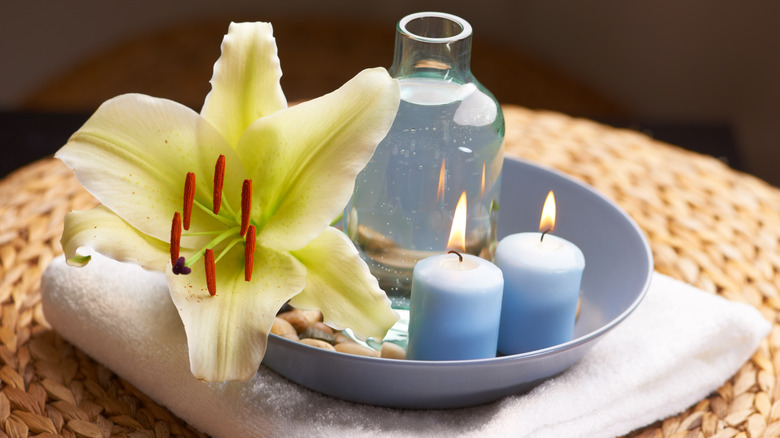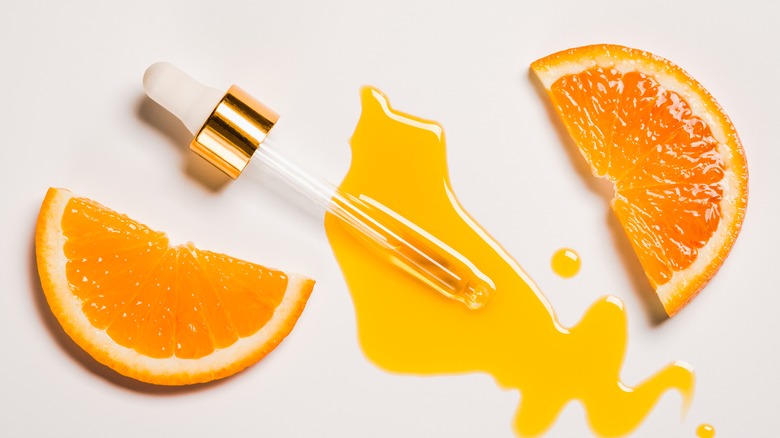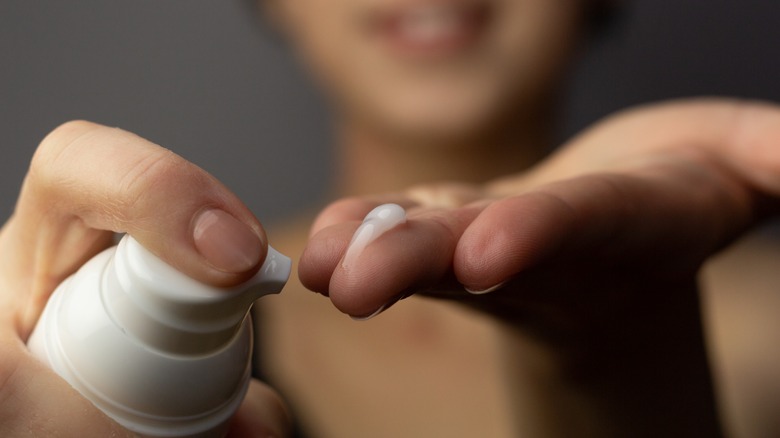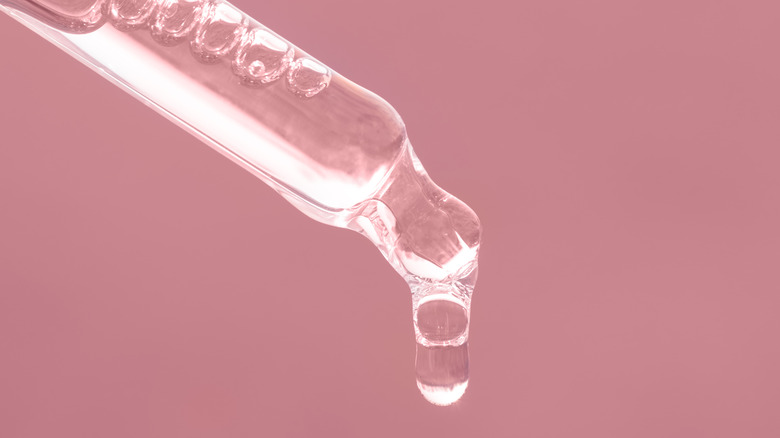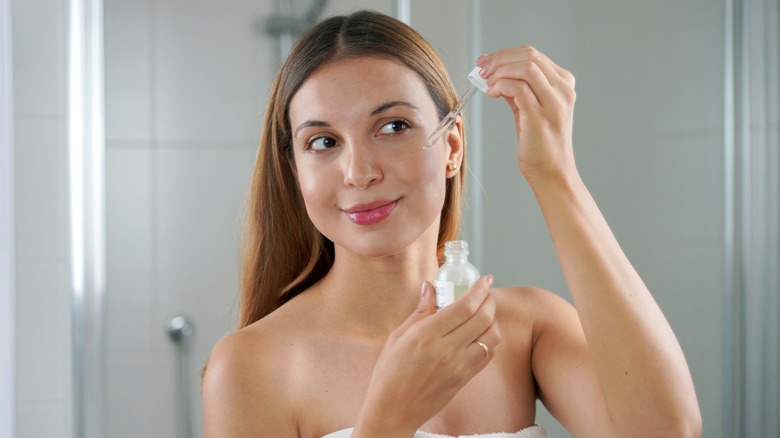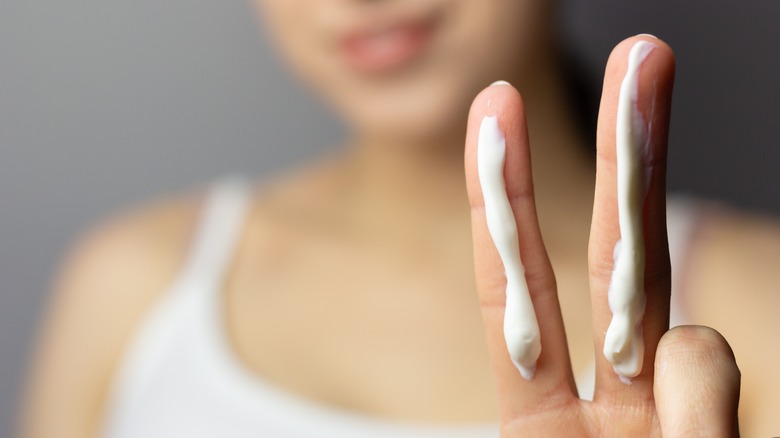The Skincare Ingredients You Shouldn't Mix With Malic Acid
We may receive a commission on purchases made from links.
Keeping track of newly released skincare ingredients can be extremely overwhelming. If you're having difficulty managing your skincare routine and don't know which products to use, the best advice is to start with the basics. You want to ensure you have an oil-based cleanser, a regular cleanser, a toner, and a moisturizer. Handling a few products at a time will make incorporating new ingredients into the mix easier, especially if you have sensitive skin. However, you want to avoid overpowering your skin with too many products that could do more harm than good.
Hearing about ingredients that fall under AHAs and BHAs can get really confusing. A simple way to remember the two is: AHAs (alpha hydroxy acids) and BHAs (beta hydroxy acids) are chemical exfoliants that work to remove dead skin cells. Specifically, AHAs help to expose new pigmented skin cells replacing areas with dark spots.
If you've been looking for a new exfoliant, malic acid is one ingredient you'll want to look out for in skincare products. Malic acid works to help improve skin texture and lighten dark spots. In addition, it's perfect for all skin types, even sensitive skin, because it's a natural exfoliant found in fruits. However, if you add malic acid to your skincare routine, there are a few ingredients you shouldn't mix it with.
Vitamin C
Vitamin C is an acid that helps to prevent sun damage and improve dark spots, wrinkles, and acne. However, when you mix it with malic acid or other AHAs, their effects can cancel each other out since they're meant to target the same areas, per Kaplan MD. In addition, Vitamin C is an unstable acid that can throw off your pH balance when you layer it with malic acid. Instead, you want to use one or the other for better results. Combining Vitamin C and malic acid can irritate your skin, harming your skin's barrier and making you break out more.
It's normal to think you can combine Vitamin C and malic acid since they're meant to help reduce the appearance of wrinkles, shrink pores, and improve dark spots. Even though you can't layer the ingredients, skincare companies have created products that hold both components, allowing them to work together effectively. However, if you prefer using both ingredients individually, you can alternate between the two throughout the week. A skincare product containing malic acid is Paula's Choice Advanced Smoothing Treatment contains four AHAs to improve sun damage and wrinkles and provide smooth and glowing skin.
Retinoids or retinol
Retinoids or retinol are forms of Vitamin A that help with anti-aging and acne. A dermatologist always prescribes retinoids because they have higher concentrations, and retinol is sold over the counter at a lower concentration. The Vitamin A ingredients are available in a lotion, cream, or serum in various skincare products and shouldn't be combined with malic acid. Because retinoids and retinol are also used to exfoliate the skin, mixing it with malic acid can over-exfoliate and cause irritation. In addition, retinoids tend to dry out the skin, so applying malic acid on top will dry out the skin more, thus damaging it.
Although you shouldn't layer malic acid with retinoids, you can use them at different times every day. For example, start your morning by incorporating malic acid in your skincare routine, and end the night with retinol or retinoid. Using your retinoids at night will enhance collagen production and produce new skin cells while the skin is in repair mode. When you apply your acids in the morning, you'll clear away dead skin cells and fill them with antioxidants and vitamins. On the other hand, you can alternate between acids and retinol every night if you don't want to use both in one day. You'll be able to figure out which routine works best for your skin by how it reacts.
Other AHAs
We mentioned how it could be overwhelming to figure out which skincare products suit your skin, and you should only mix a few. So, if you're interested in using malic acid, it's important to note that you shouldn't combine it with other AHA products. Too many acids on the skin can cause irritation and dryness, as we've discussed with other ingredients. While everyone has a different skin tolerance, you might get away with using a few AHAs together, but it's best to alternate between a couple or avoid them altogether.
Similar to the combination of Vitamin C and malic acid, using more than one AHA product can prevent them from benefitting the skin and its needs. Other AHAs include glycolic, citric, tartaric, mandelic, and lactic acid. You can pair malic acid to target dark spots and citric acid to help neutralize your skin's pH balance. Again, you'll want to test out how your skin will react to it by using it twice a week, and if your skin isn't irritated, you can continue using them.
BHAs
Lastly, you don't want to mix malic acid with other BHA products to prevent irritation on your skin. Various skincare products are made with AHA and BHA ingredients that you could add to your routine. They'll work better in a single product than using two separate products. However, if you're using a cleanser that is an AHA and a toner that is a BHA, as opposed to two different serums, you could use them simultaneously. When shopping for skincare products with malic acid, check the ingredient list to see which other AHAs and BHAs are included to replace other products you might already own.
One product containing malic acid and various other acids is Paula's Choice Skin Perfecting 25% AHA + 2% BHA Exfoliant Peel. It's a liquid-gel texture exfoliator you rinse off after 10 minutes, and it will improve texture, wrinkles, sun damage, and unclog pores. The exfoliant peel has ingredients of lactic, mandelic, glycolic, malic, and tartaric acid (literally every AHA), and its BHA, salicylic acid. Since this product has AHAs and a BHA, you wouldn't want to use any other products with these ingredients to prevent irritating and over-exfoliating the skin.
Always follow up with sunscreen
Applying AHAs to your face increases UV sensitivity and hyperpigmentation, increasing the risk of premature aging. If you're on top of your skincare routine, following every step and doing it every day, but forget to apply sunscreen, your hard work goes out the window. If you've started using retinoids at night and save your acids for the morning, skipping sunscreen will damage your skin's barrier, primarily if you use a highly concentrated retinoid. In addition, you'll have to wait even longer to see results if you've started noticing changes to your skin's texture and overall appearance.
There are various types of SPF, but the recommended level is SPF 30. You can get SPF 40 and SPF 50 for extra protection if you're outside for long hours. It's also essential to reapply every two hours for the sunscreen to work effectively. Once you find the right sunscreen you love, stick with it and use it daily. A popular sunscreen every skincare guru talks about is Supergoop's Unseen Sunscreen; that's SPF 40, doesn't leave any white cast after you apply it, and works excellent under makeup.
